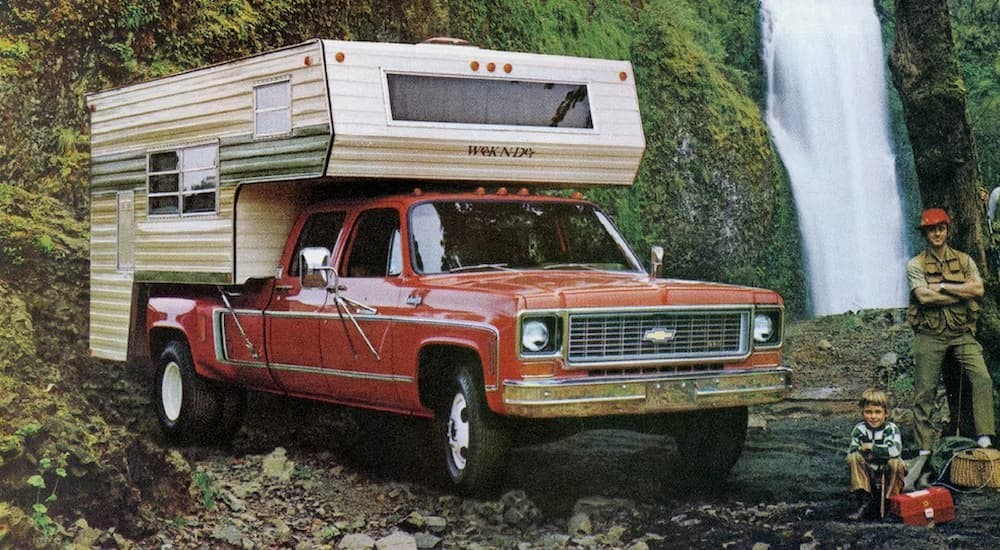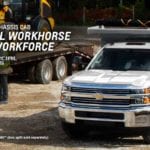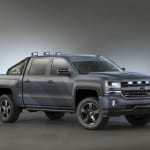Shopping for a Chevy Silverado for sale today looks vastly different than it did decades ago, when trucks were nothing more than utilitarian workhorses that made little effort to prioritize comfort. They were merely one more tool in a worker’s arsenal—but that has since changed.
Best-selling models like the Silverado prove that drivers no longer have to choose between capability and comfort because the Silverado can tow heavy loads, efficiently navigate commutes, and explore the unknown without missing a beat. It’s a work partner, an adventurer, and a chariot; it’s versatility at its finest.
The Silverado’s well-roundedness is impressive, but what’s truly remarkable is the journey that got us here. Of course, it’s easy to look at models like the C/K Series and compare it to the Silverado in terms of power, amenities, and technologies, but appreciating that evolution reaches a new level when you discover individuals like Paul Hitch, an engineer that spent his entire career with General Motors.
As Chevrolet’s Chief Truck Engineer, Mr. Hitch had helped set the stage for the Silverado we know and love today. His contributions are nothing short of outstanding, with his passion for this automobile defining his 102-year life. Here’s a closer look at his incredible legacy and lasting impact.
Big Dreams at Eighteen
Indiana was a breeding ground of ingenuity in the 1920s and 1930s, with many automakers setting up shop in Indianapolis. As a kid growing up in the area, it was impossible not to fall in love with the automobile.
“Indianapolis used to be an automobile center,” Hitch said of growing up in Indiana during the automobile boom. “We had Stutz and Dusenberg, which were really up-end automobiles. And then, of course, we had the Indianapolis 500—so, naturally, I was interested in cars.”
Although the Great Depression forced many of those companies out of business, Hitch was determined to join the industry and was hired by General Motors at 18. There was, however, one caveat.
Hitch was hired as a student, with his employment based on his enrollment at the General Motors Institute of Technology in Michigan. Known today as Kettering University, the General Motors Tech Institute was renowned for its engineering program that produced high-level graduates for the burgeoning automotive industry. Hitch was among those in 1939, returning to Indianapolis as a mechanical engineer and assuming his position as a junior engineer with GM.
“I started as a GM Tech Student at the old Martin Parry plant, and shortly afterward, GM started building a new plant over the old Martin Parry plant,” he recalled. “It became the largest stamping plant in the United States with all new machinery. It was a nice place to work.”
After a few years in Indianapolis, Hitch transferred to Detroit—the heart of the American automotive industry. At the dawn of World War II, he lent his expertise to the Cadillac Engineering team and helped develop Army tanks before he was called to service with the Navy.
After three years with the Navy, Hitch returned to his position at General Motors, working in Indianapolis and Detroit before being tasked with designing the Allison J-35 jet engine with teams in New York and New Jersey. Once the project was finished, he transferred to Michigan in the 1950s and, a decade later, landed the opportunity of a lifetime when he was named the Chief Engineer for Chevy Trucks in 1965.
Hail to the Chief: The Transformative Power of Chevrolet
Paul Hitch worked quietly behind the scenes for years but was integral in designing some of Chevrolet’s most iconic vehicles. He was party to modernizing the Suburban and proudly gave the Ford Bronco a run for its money with the iconic K5 Blazer. He also helped redefine the truck segment with the 1973 Chevy pickup, the third-generation C/K—a modern marvel that marked the first time Chevrolet focused on ride quality and handling. For Hitch, it was revolutionary.
“1973 was my best truck. It’s still a good truck,” Hitch said in one of his last interviews in 2018, at the age of 101. “I had some good engineers, and they did a great job on ride and handling. We hadn’t really done too much development work on ride and handling before. That was the biggest improvement we made.”
That focus ultimately set the tone for future Chevrolet trucks, with the Silverado providing one of the smoothest rides in the segment today. It’s a characteristic that many of us take for granted; we’ve grown so familiar with smooth truck handling that our modern standards expect it.
Thinking Outside the Box
While the 1973 pickup truck was pivotal for Hitch, his experience as Chevrolet’s Chief Truck Engineer speaks volumes about his success in thinking outside the box.
Today, it’s easy to imagine the engineers behind the Silverado working closely with other departments to resolve common driver concerns or issues, finding what works and what doesn’t to finetune the design. However, this multi-departmental collaboration wasn’t prominent in the industry during Hitch’s early tenure. Instead, engineers, salespeople, and service technicians didn’t interact or collaborate, which made Hitch’s job a real challenge.
The sales team could provide insight into what customers were looking for in their trucks, while feedback from the service technicians would reveal issues or common problems that needed to be resolved at the factory level. However, Hitch didn’t have that luxury and had to find a workaround—and his solution was brilliant, showcasing his ingenuity.
“I would ask my fellas any time they go by a dealership to stop by and look at the junk pile,” he said. “What’s in the junk pile? So that was one source of finding problems that we had.”
Hitch encouraged his team to browse those junk piles, but General Motors also let him buy competitor models. His team tore the vehicles down and studied every component—a practice that remains in place today as technicians catalog every vehicle down to the nuts, bolts, and rivets, what they’re made of, and how much they weigh.
Hitch’s Impact: A Lasting Legacy
General Motors transferred Hitch to Vauxhall Motors in Luton, England, in 1976, where he retired after 43 years in 1978. He returned stateside, settling down with his wife in Savannah, Georgia, where he often frequented the local Chevrolet dealership to check out new models.
For Paul Hitch, he never imagined a Chevrolet truck could appeal to drivers as anything other than a workhorse.
“Trucks have become a pleasure vehicle, not a work vehicle,” he said. “I can’t imagine how much they have improved from what we did in our days.”
Hitch’s insight is surprising, considering he’s credited with making Chevrolet’s trucks better all-around performers and designing some of the most popular trucks in Chevrolet history, not to mention icons like the Blazer. Although creating the third-generation C/K truck was challenging in the 1970s, Hitch’s success in making the truck comfortable and responsive set the standard for the modern truck and the C/K’s successor, the Silverado.
Today, we demand this quality and performance in our trucks, relying on their versatility as all-around road warriors that can handle every task, from towing heavy trailers and navigating our commutes to keeping our families safe as we venture out of town.
Even though Hitch didn’t realize it then, he was integral in redefining the truck segment and our expectations. His ingenuity in thinking outside the box laid the foundation for the Chevy Silverado, which presently occupies street-facing prominence at dealerships nationwide. Moreover, Paul Hitch helped prove trucks could do more and be more.
He may not have realized the capacity of “more” and what that would mean for the future of Chevrolet’s truck lineup, but he discovered it long after he retired when he visited his local dealership. Today, Chevrolet attributes its success in shaping the American automotive landscape to engineers like Paul Hitch.
For Chevy, Hitch helped set a precedent—a benchmark in modern truck design—with Hitch’s 1973 C/K truck likened to the giant on which the current Silverado stands.




